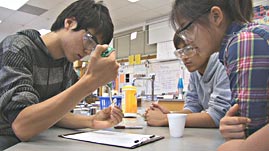Teachers' Domain - Digital Media for the Classroom and Professional Development
User: Preview

Source: Produced by WGBH Educational Foundation in association with the Amgen Foundation



In this video produced by WGBH, high school and middle school students in the Amgen-Bruce Wallace Biotechnology Lab Program use real-world research equipment and techniques to separate a genetically engineered protein from other molecules in a cell. As an industry research scientist explains, this process—called protein purification—is commonly used in research and development of disease therapies. The video also explores some of the reasons people have for choosing a career in science, including the rewards of knowing their work is helping others.
While no two scientists are alike in personality, most share these traits: a passion for learning new things, a curiosity about how things work, and a desire to help people. Scientists working in biotechnology, including biochemists, biophysicists, and molecular biologists, study processes that affect growth, aging, and other aspects of human health and investigate how foods, drugs, or other substances affect the body. As demonstrated in this video, these researchers employ a variety of techniques in their experimental work that they must perform with extreme care and attention to detail.
Students planning a research career, especially those interested in emerging medical therapies, should earn at a minimum a bachelor’s degree. Beyond requisite courses in chemistry and biology, undergraduates should study related disciplines, such as mathematics, engineering, physics, and computer science. Graduates may find entry-level work in testing and inspection, as a lab technologist, as a technical sales or service representative, or in some cases as a research assistant.
Those wanting to pursue an advanced degree can then specialize in a field of study, such as biochemistry, molecular biology, immunology, or genomics (using complex computer programs to study genes). While a master's degree may be enough to get an industry job in applied research or product development, a doctorate (PhD) is needed to conduct independent research or to obtain a university faculty position. Some biomedical scientists also possess a medical degree (MD).
In addition to formal education, some biomedical scientists spend several years in a postdoctoral position before they apply for jobs in industry or pursue other career paths. Postdoctoral work provides valuable laboratory experience with specific processes and techniques, such as gene splicing. Skills and techniques gained may be transferred to other kinds of research projects.
 Loading Standards
Loading Standards